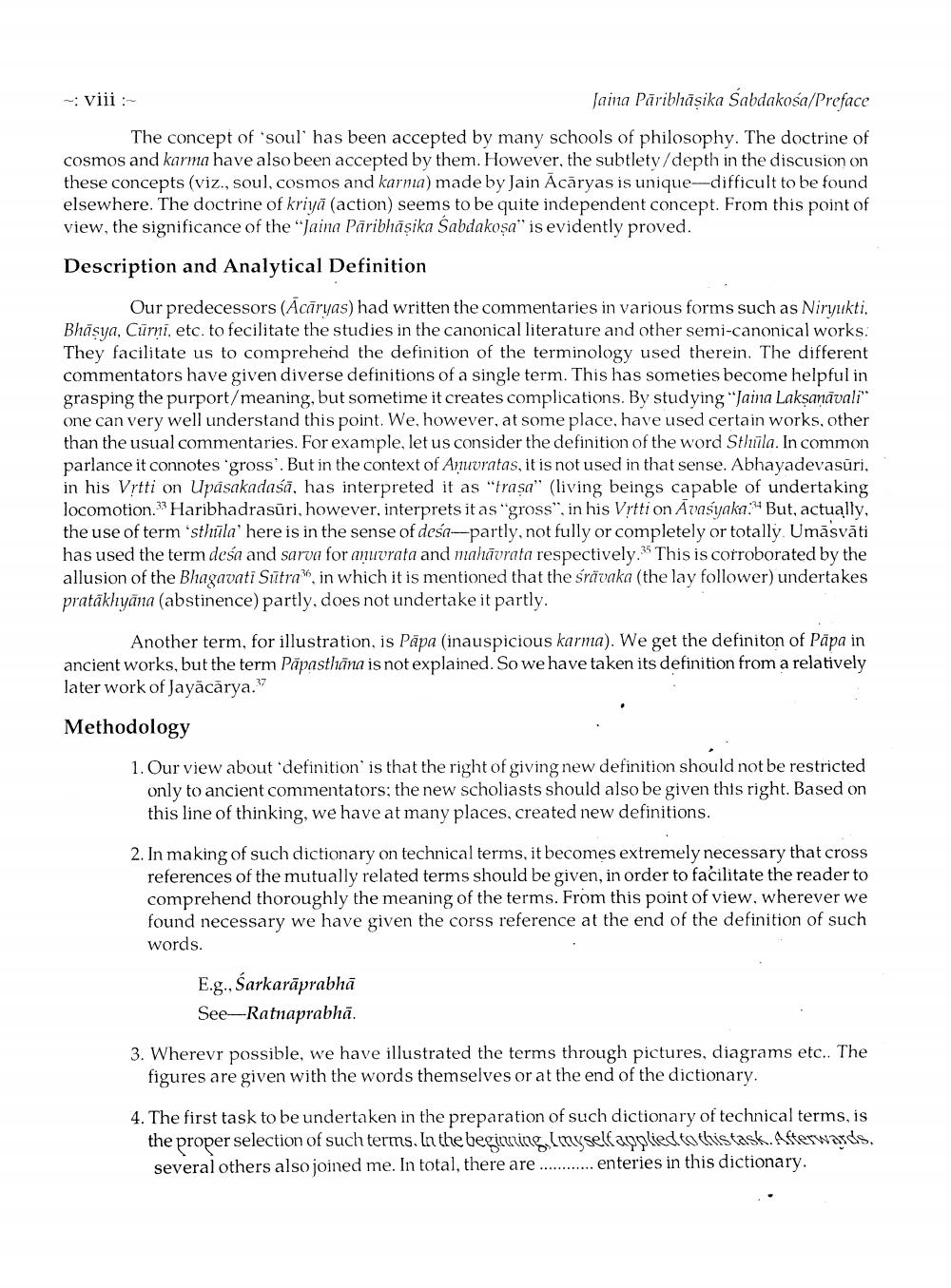Book Title: Jaina Paribhashik Shabdakosh Author(s): Vishrutvibhashreeji, Mahendramuni Publisher: Jain Vishva Bharati View full book textPage 9
________________ ~: viii : Jaina Päribhāṣika Sabdakosa/Preface The concept of "soul" has been accepted by many schools of philosophy. The doctrine of cosmos and karina have also been accepted by them. However, the subtlety/depth in the discusion on these concepts (viz., soul, cosmos and karma) made by Jain Acaryas is unique-difficult to be found elsewhere. The doctrine of kriya (action) seems to be quite independent concept. From this point of view, the significance of the "Jaina Paribhāṣika Sabdakosa" is evidently proved. Description and Analytical Definition Our predecessors (Acaryas) had written the commentaries in various forms such as Niryukti, Bhāṣya, Curni, etc. to fecilitate the studies in the canonical literature and other semi-canonical works. They facilitate us to comprehend the definition of the terminology used therein. The different commentators have given diverse definitions of a single term. This has someties become helpful in grasping the purport/meaning, but sometime it creates complications. By studying "Jaina Lakṣaṇavali" one can very well understand this point. We, however, at some place, have used certain works, other than the usual commentaries. For example, let us consider the definition of the word Sthila. In common parlance it connotes 'gross. But in the context of Anuvratas, it is not used in that sense. Abhayadevasūri, in his Vṛtti on Upasakadasā, has interpreted it as "trasa" (living beings capable of undertaking locomotion. Haribhadrasûri, however, interprets it as "gross". In his Vrtti on Amasyakan But, actually. the use of term 'sthula' here is in the sense of desa-partly, not fully or completely or totally. Umāsvāti has used the term desa and saron for anuvrata and mahavrata respectively." This is corroborated by the allusion of the Bhagavati Sutra, in which it is mentioned that the śravaka (the lay follower) undertakes pratakhyāna (abstinence) partly, does not undertake it partly. Another term, for illustration, is Papa (inauspicious karma). We get the definiton of Papa in ancient works, but the term Papasthana is not explained. So we have taken its definition from a relatively later work of Jayācārya." Methodology 1. Our view about 'definition' is that the right of giving new definition should not be restricted only to ancient commentators; the new scholiasts should also be given this right. Based on this line of thinking, we have at many places, created new definitions. 2. In making of such dictionary on technical terms, it becomes extremely necessary that cross references of the mutually related terms should be given, in order to facilitate the reader to comprehend thoroughly the meaning of the terms. From this point of view, wherever we found necessary we have given the corss reference at the end of the definition of such words. Eg.. Sarkarāprabhā See-Ratnaprabha. 3. Wherevr possible, we have illustrated the terms through pictures, diagrams etc.. The figures are given with the words themselves or at the end of the dictionary. 4. The first task to be undertaken in the preparation of such dictionary of technical terms, is the proper selection of such terms. In the beginning. I myself applied to dus task. Afterwards. several others also joined me. In total, there are. .........enteries in this dictionary.Page Navigation
1 ... 7 8 9 10 11 12 13 14 15 16 17 18 19 20 21 22 23 24 25 26 27 28 29 30 31 32 33 34 35 36 37 38 39 40 41 42 43 44 45 46 47 48 49 50 51 52 53 54 55 56 57 58 59 60 61 62 63 64 65 66 67 68 69 70 71 72 73 74 75 76 77 78 79 80 81 82 83 84 85 86 87 88 89 90 91 92 ... 414
